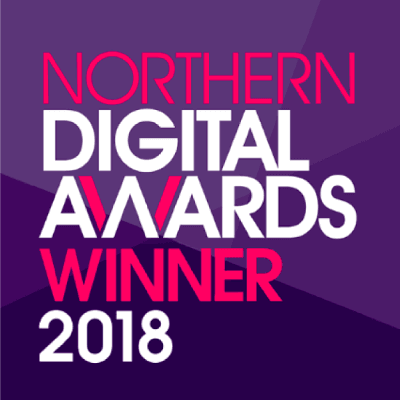The 10 Golden Rules of User Experience Design
It’s hard to think of a digital marketing channel or discipline that doesn’t benefit from a strong focus on user experience.
From maximising conversions from pay-per-click advertising, to supporting SEO by increasing the quality of on-site content, user experience design can turn a good digital marketing campaign into a great digital marketing campaign.
For a focus on user experience to add value, it has to be informed by best practice. In this blog post I’ve detailed the 10 golden rules that we at Blueclaw follow in our design and development team. I hope you enjoy it!
1. Understand the Basics - What is Design?
Going back to basics, it’s worth considering what we mean by ‘design’.
I generally believe there are two lines of thinking when it comes to design - stylistic design and interaction design.
At Blueclaw we most usually we produce interaction design pieces that allow for engagement via content, UI and stylistic merits.
This, in turn, produces something that has meaning and purpose for both the business and the user.
“People ignore design that ignores people.”
— Frank Chimero, Design Director at Abstract
When designing something new, it’s not just a simple case of putting pen to paper and creating; it’s the coming together of processes and people to think, define, create and master a product, then learn from problem-solving and grow in experience.
Yes, this all sounds very serious - but the process is fun, and the results of good design can give an exceptional boost in digital marketing.
Design is very much a collaboration of ideas and people, getting excited, being pushed and realising something better than their own individual thoughts made real.
The main goal of design is to fulfill the needs of a user and offer something simple, thought-provoking, useful, convenient, fun or all off the above.
A good designer is, essentially, a problem-solver, designing our way to better functionality and more engaging messages.
“Design can be art. Design can be aesthetics. Design is so simple, that’s why it is so complicated.”
— Paul Rand, Designer
2. Research your World
This idea always reminds me of the Matrix, in that we should all see the world as it really is - dramatic I know, but trust me it will all make sense soon enough.
Our day to day life is followed by design and this design can dictate everything that we do from sleeping to eating to socialising and everything in-between.
Next time you have 5 minutes spare, stop what you are doing and seriously over-analyse everything in the room.
Look at the doors, look at the chairs, tables, cups, computers etc. and see what they offer, understand their relationship with you, realise the feedback this produces and see where they came from.
Classic examples for myself are doors (again bare with me) and the ever famous Heinz ketchup bottle (seriously!).
From the above example, we all understand seeing a door with a handle like this as being a pull door but how many times have you discovered it is a push door?
Something so simple can be so irritating for a user, thus making this a great example of a bad design choice.
My other example shows when user research can make an experience better.
This is a classic example to me, Heinz clearly does its research and gets it right with such a simple change.
The little change of flipping the sticker/branding the other way actually made the product more engaging and presented a greater user experience by providing better feedback of orientation.
Sure, at a basic level it’s a silly and simple idea but it worked wonders for the company and the product.
So, how do you implement a good user experience in your design?
Through user research, prototyping and connecting with industry leaders. Tools like Hotjar and Google Analytics offer insight into your users and what they are doing and gives you an opportunity to solve problems to achieve your business goals.
Doing things like surveys help connect with the user on a personal level, allowing you to empathise with them and fixing any issues in order to gain more trust. Also, read white papers and case studies, like ours, to gain some industry information and see what others are doing.
The takeaway here is to:
- Research
- Analyse
- Connect
- Empathise
- Solve problems
Follow these steps and you lay the best foundations for any design-driven project.
“Design is not just what it looks like and feels like. Design is how it works.”
— Steve Jobs, Apple
3. The Processes
Like with anything, you need to plan and move forward to defeat any failures along the way, so of course, you need faithful processes.
As mentioned before, all designs start with:
Research. Browse industry leaders and failures, see what worked and what didn’t see where the market is going and if there is value in it. Understand the users by seeing what they want and need, and what effect using the product may produce.
Observation: Experience real and digital products and write down/understand your own experiences and how you would improve it. Remember the word “empathise” and be the advocate for the user.
Discussion: Have open talks with friends, family, and colleagues about your ideas so they can evolve or see past your original thought. This should be an ongoing affair through everything that you do.
Analysis: Once you have collected data and have ideas, it’s time to find meanings. Find relationship in the insights, look for similar outcomes or motives, find patterns in and between the lines.
Now you can develop statements from the findings which hopefully should create questions/problems for you to ask and begin to solve.
Understand the Business Goals: Remember your goal is to get results and those results are set by the business you work for. You have to understand sometimes what the user needs isn’t what the business wants so…. how do you fix this?
User-flow Diagrams: Grab some paper, some sticky notes, and your team and work out how you want the user to engage with the product. This will teach you where they come from, what their expectations are etc.
Wireframing: Browse the web and/or real-life objects and view them as basic objects. Get a feel for them if you stripped them back of colour and stylistic feedback to just their core elements and be inspired.
Here, should be the basic shell of the product or interface, showing the interactions, the content areas, and basic journey. This helps you visually create a story for the user to follow.
Prototype: This can be a paper prototype, visual animated prototype or a digital prototype as long as it’s something a user can use and engage with. You should be able to see how someone will work with the product, demonstrate flaws/problems and to see if the needs are answered.
Design: Start to bring in hierarchy, themes, moods, and meanings with the use of visual elements. This includes photography, colours, placements, fonts, feedback states, menus, and content. This is your style but also produces the connection and forms the relationship with the user.
Test: Simply test your design. This should be something done from the wireframing process all the way to, well, forever if possible. Testing at early stages stops bugs and any issue being released to your audience, but testing after release gives you a chance to develop the product and yourself as a designer.
You can gain value and insight from how the product is perceived and used to make it better and user-friendly.
Remember, this is just a list - not a concrete running order. We believe researching, gaining feedback and testing is always a continuous process to ensure we get the best results.
4. Tools for Design
The market is pretty much saturated with tools for UX and design, both free and not so free, with some very obvious front-runners.
Personally, I use Adobe Illustrator, Photoshop and any other Adobe products because I am a bit of an Adobe fan, but I have played with a few others such as Sketch.
Every tool offers generally the same thing with slight differences, but it’s a good idea to play and experiment with these. It will help see what you enjoy to use, what you have been missing and, most of all, shows you other experiences with different products.
This is a great excuse to sit back and understand the product while you use it.
One that sometimes gets forgotten about is a simple pen and paper. It’s a great old tool in that notes and various concepts can be made, interchanged and adapted to suit your needs, plus you can do it anywhere and you don’t have to wait for your device to boot up.
This isn’t limited to the obvious design tools, but also time-keeping tools such as Monday.com or Tom’s Planner, or even storage when you create a lot of generic assets and/or have a library of assets you tend to use.
We can’t forget about the research side, however! Software like Hotjar and Google Analytics, Optimizely for A/B testing, online management with the likes of Trello and collecting data with Survey Monkey all have important roles to play in your final design.
Bar from technical tools, I would suggest you develop other tools such as personal soft skill sets. Learning to be a better listener, writer, sketcher etc are great ways to help support your day to day work life and allow to build great relationships and identify with products and yourself.
5. The Power of Content
You more than likely heard this before, but I must stress how important content is.
It is the substance - the reason why the user is there, the reason for the design itself - it holds most of the value of what you are designing, so it needs to be clear and concise while knowing who it is talking to and/or for.
As a designer, this shapes what I create. It gives what I am working on purpose and helps me understand what a user will need and might not need.
Read the content you’re designing around - not just the title. Trust me, I have worked with designers in the past who ignore this rule countless times.
Having too much or not enough content is important and to virtually hold someone’s hand throughout would be impossible if you don’t read it yourself.
You can offer visual cues, interactions to sections, hide or show content and give hierarchy. I try my best to think of a worst case scenario to ensure what I create can work no matter, but don’t be afraid to play on this as sometimes this can be your best friend.
“If you don’t talk to your customers, how will you know how to talk to your customers?”
— Will Evans, Chief Design Officer at PraxisFlow & Founder of Lean UX NYC
Things to think about here are - what are the themes of the product? Who is the product for? Where and when are users most likely to see/use the product? What is the value of the product?
These factors play a massive role in showing how something will be perceived and have meaning. Again, a lot of this will come with research and knowing your audience; it’s truly the secret power to storytelling and expression.
If your product has no value or is unable to tell a story, then how can you expect users to relate or even conflict with the product?
Another keynote here is to remember that less is more. Users are generally busy and our minds, as well as our attention spans, are ridiculously low, so giving a user a million and one things on a single page might sound like an easy way to display everything, but it all ends up being confusing, working as clutter and just being plain old distracting.
“Progressive disclosure” is the term needed here.
It means to show little by little depending on what tasks are needed to be done at a given time. Know where the user wants to travel to, guide them as though you were holding their hand, give visual examples and breadcrumbs to where they are going and have been.
Imagine for a second you were blindfolded and taken to a different city you have never been to before, then having the blindfold removed and told you to have to make it back home.
The road signs should be simple for you to navigate back without you being worried or even feeling lost even though this is all new to you. This is how a product, website, content marketing asset or digital design should be, basically - make it simple and worry-free.
6. Mobile First
As if designing didn’t have enough restrictions with user attention spans, we also have to contend with lack of real estate with mobile devices and the reality of using them.
As you research and wireframe, work along the lines that it will be made for a smartphone and understand what rules govern this.
Both Apple and Android as well as Google offer masses of advice for guidelines towards their products and the web itself, so I do tend to find myself over on their sites to refresh myself now and then.
In terms of use, mobile devices are always on the up and up for web and app use but still, you must remember that users tend to use these devices on the go - so making the user journey clear and obvious is key.
This way of thinking can be great too. Changing and developing design has quickly removed obsolete traditional UI to be replaced with AI, giving way to better interactions and experiences.
An example of this would be user type form; AI allows data to be filled in and even track user behaviors and give suggestions, all based on online behaviors. Facebook and Google are key players in this and are leading the way (minus the issues from before).
“Usability rules the Web. Simply stated, if the customer can’t find a product, then he or she will not buy it.”
— Jakob Nielsen, Usability expert and Principal of Nielsen Norman Group
Another consideration is user behavior. We expect things so fast and want everything now. Making images too high res or missing a key feature will have devastating effects and ruin your results.
Of course, Blueclaw is very much an SEO agency so we focus a lot on qualitative aspects of SEO such as site speed, mobile-readiness, and performance so getting these things right for the end user, as well as Google’s robots are key.
7. Empower the User
UX is about the user - it’s literally in the name. It’s about focusing the attention on a user, giving them flexibility, empowerment, and feedback in every case.
A user should be given solutions and constant UI so the product is engaging and easy to use. A good principle is to avoid making the user think about how they are engaging and navigating your design… the second this happens they will be gone.
- Keep it simple
- Be obvious and clear
- Reward and feedback to users
- Don’t waste time or provide roadblocks
- Realise the user’s tasks and demands at hand
“Users are not always logical, at least not on the surface. To be a great designer you need to look a little deeper into how people think and act.”
— Paul Boag, UX Consultant
8. Learn, learn, learn….. and learn some more.
Being part of a creative world, you will find everything tends to evolve or change rapidly, so you need to keep on top if you want to continue to be good. This doesn’t just stop any creative blocks but also makes you a better designer. There are so many things to experience and learn from whether it be theories, systems and/or results in studies.
The best way I believe is to learn from your results the most. See where you went wrong, what strengths your product had and grow.
If you don’t know what you are good at and not so good at then how will you get better? You have more experience and know how to problem solve faster, thus making you a UX machine dominating the land with your power of knowledge!
9. Do Something Different
This isn’t just a rule of UX but of life really. Change things up, try something new, develop your weaknesses and you might just surprise yourself.
For myself, I am currently learning techniques from our front-end dev team. This allows me to think about systems and transitions beyond what I can see.
I see new possibilities and - if anything - actually appreciate what they do more. Again, it’s about empathising!
Another good point with this is to set some time aside to read more. There are so many case studies, including ours, to learn from. You will always find new ways of doing something and it keeps you up to date.
If you feel you don’t have the time, subscribe to websites like Smashing Magazine or Medium to give you basic chunks of insight that you can come back to at a later date or even our blog and white papers which offers some great advice and updates.
So yes, get out of the routine and gain more empathy and understanding of other departments and other ways of thinking as you will be a better person, marketer and digital designer for it.
10. Share
The last point, share with your teams. I always feel this is rather important as it aligns others to your thinking and you to theirs. It opens up new ideas and feedback to what has been or is going to be and so is very useful indeed.
This can be made further afield with searching for nerdy communities and workshops outside of work. This gives you the chance to network and hear experiences outside of your own industry or even world, and make some great friends along the way.
Now you’ve gained some insight into UX, check out the five content marketing tools you can’t live without.






